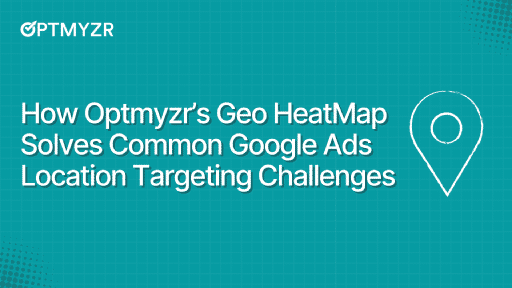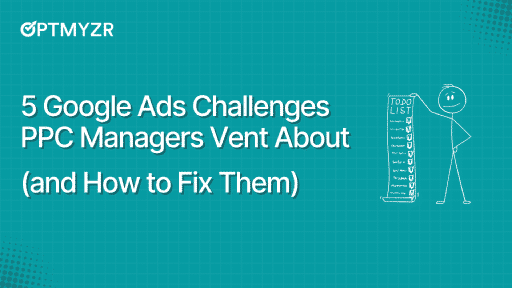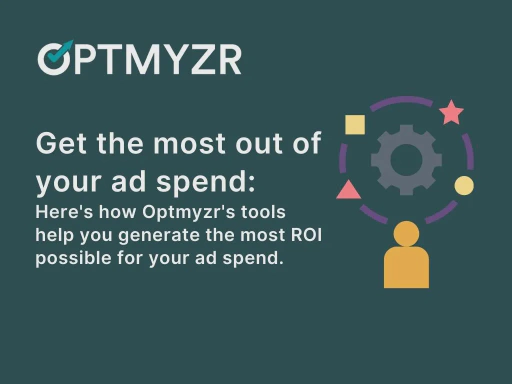Marketers on Reddit recently opened up about the less obvious Google Ads optimizations that delivered outsized results. The kind of tweaks that don’t get much attention but drive serious performance gains.
The catch? These tactics are often manual, time-consuming, and hard to scale across multiple accounts.
That’s where Optmyzr comes in.
You can automate, scale, and monitor all five of these underrated (but powerful) optimizations without adding more to your plate.
Here’s how to put them into action today.
1. Automate negative keyword management
Negative keywords tell Google which searches not to show your ads for, so you don’t waste budget on irrelevant clicks.
Simple in concept but messy in execution.
That’s what makes this optimization underrated: It’s easy to overlook, hard to scale, and almost impossible to manage well across multiple campaigns without automation.
How Optmyzr helps
For Search Campaigns
The Negative Keyword Finder (Search) pulls your Google Ads or Microsoft Ads search terms report and breaks queries down, showing you exactly which ones are wasting spend.
- See key metrics at a glance: impressions, clicks, CTR, cost, CPC, conversions.
- Add individual words or full queries as negatives.
- Bulk-edit match types, archive irrelevant suggestions, or apply changes to shared lists.
- Push changes to accounts or campaigns instantly (no spreadsheets, no tab-hopping).
💡 Need more suggestions? Turbo Mode lowers data thresholds to uncover more underperformers. |
For Shopping Campaigns
The Negative Keyword Finder (Shopping) acts like an A/B test for queries across ad groups:
- Duplicate Queries: Finds search queries showing in multiple ad groups, identifies the underperforming one, and suggests adding it as an exact match negative.
- Low-Performing Queries: Surfaces queries within an ad group that have low ROAS or high cost/conversion compared to the group average, and recommends them as negatives.
This ensures traffic is automatically funneled to the most profitable ad groups while cutting out generic or budget-draining clicks.
2. A/B testing ads
Running multiple ads per ad group is a smart move as it gives your account room to test, learn, and improve. But in the day-to-day of campaign management, it’s easy for ad copy to go untouched for weeks or months.
Ads stay live for months (sometimes longer) without being reviewed, rotated, or refreshed. And while Google may rotate ads automatically, it doesn’t always align with your actual business goals. Without a structured way to A/B test and replace ad copy, most campaigns face performance issues.
Why this optimization gets overlooked:
- One ad quietly eats up the budget but doesn’t convert.
- Another performs better, but never gets prioritized.
- Google rotates ads, but not always in a way that aligns with your goals.
- Without structured testing, performance flatlines, and you don’t know why.
A/B testing your ad copy is one of the easiest ways to improve CTRs and conversion rates. But only if it’s done consistently, which is tough to manage manually across multiple accounts.
How Optmyzr helps
Optmyzr makes it easy to test ad copy, find what works, and keep your best-performing ads live (all in one place).
Here’s how:
Automatically compare ad performance
Optmyzr’s A/B Testing tool compares ads within the same ad group and tells you which ones are underperforming. It will then suggest pausing these ads, and you can also create a new version right from the same tool.
Quickly create new RSAs
Need to replace a paused ad or create new ones from scratch? Optmyzr helps you build Responsive Search Ads (RSAs) in bulk:
- Use AI-powered suggestions for headlines and descriptions.
- Pull in content from your existing ads.
- Create RSAs across multiple ad groups and accounts in just a few clicks.
Update or repurpose winning ad copy
The Ad-Text Optimization (RSA) tool helps you iterate on ads without starting from scratch:
- Find and Replace: Make quick text edits to update tone, offers, or branding.
- Bulk CSV Upload: Download ad copy, make edits in a spreadsheet, and upload to create new ads fast and in bulk.
💡Also Read: New to Optmyzr? Here’s What You Should Test In Your Free Trial Period
3. Optimize budget allocation based on product profitability
Not all products are created equal, and they shouldn’t be treated that way in your ad campaigns.
Some products generate high profit margins, convert easily, and perform well even with minimal advertising spend. Others might look good on the surface but consistently drain your budget without delivering real returns.
However, standard campaign structures in Google Ads often treat all products the same.
Without clear segmentation based on actual performance, you might waste budget on the wrong products.
Why this optimization gets overlooked:
- Profitability isn’t always reflected in campaign data.
- High-performing, low-cost products often get buried.
- Manually segmenting product groups is time-consuming and hard to scale.
- Merchant Center feeds don’t automatically adjust to performance shifts.
- Managing bids across large inventories without automation is nearly impossible.
This makes it easy for inefficiencies to creep in, especially when product catalogs grow or performance fluctuates quickly.
How Optmyzr helps
Optmyzr’s Smart Product Labeler is built specifically to solve this challenge in Shopping and Performance Max campaigns. It helps you automatically segment your product feed based on real-world performance, so you can allocate budget and bids where they’ll have the most impact.
Segment products by performance
The Smart Product Labeler assigns every product to one of five custom performance categories:
- Heroes: Top-performing, high-ROAS products. Great candidates for increased bids and budgets.
- Sidekicks: Solid performers close to breaking out. Gradually increase spend here.
- Villains: High-spend, low-ROAS products. Reduce bids or consider excluding.
- Zombies: Low-traffic items that haven’t had enough exposure yet. Use test-and-learn strategies.
- Flukes: Surprisingly high-ROAS products with minimal exposure. Nurture with moderate bid increases.
The segmentation is based on ROAS and Cost, so you’re acting on what truly matters, not just impressions or clicks.
Keep labels automatically updated
No need to constantly download reports or adjust feeds manually.
As performance changes, the Smart Product Labeler automatically updates your product labels, keeping your strategy in sync with reality.
4. Selective conversion reporting on lead gen campaigns
Instead of counting every lead from your campaigns as a conversion (like anyone who fills out a form), only count the leads that are actually valuable, such as those that are qualified or result in a real sale.
When you do this, your cost per lead (CPL) may look a little higher, but it will be more accurate.
In the long run, your client will see a much better close rate (more sales from those leads) and will actually spend less money per sale overall.
👉 In short: Don’t focus on reporting every lead. Focus on the ones that matter; it saves money and gives a clearer picture of success.
How Optmyzr helps with selective conversion reporting
Optmyzr makes it easier to turn offline conversion data into actionable insights.
While the actual import of offline conversions happens in Google Ads (from your CRM or sales platform), once those conversions are in Google Ads, Optmyzr can help you report, analyze, and optimize campaigns around them.
Using the Rule Engine, you can:
- Build custom rules that track only qualified leads and closed deals (not all leads).
- Automate reporting so that only the most valuable conversions show up in your reports.
- Optimize efficiently by targeting your spend toward campaigns, ad groups, or keywords that drive real sales.
- Create scalable workflows that automatically identify high-cost/low-return segments and shift budget to better-performing areas.
Here’s a sample workflow:
If you’d like to see how this works in action, our team would be glad to walk you through this and other strategies you can build in the Rule Engine. Feel free to book a demo here.
5. Landing page A/B testing
Your ads can be perfectly targeted, but if the landing page falls flat, conversions won’t follow.
Small changes like making calls-to-action more prominent or trimming down long, cluttered pages can deliver massive lifts in performance.
Why this optimization gets overlooked:
- Landing page testing often requires designers, developers, or third-party tools.
- It’s hard to quickly see which pages are draining the budget without conversions.
- Winning page elements don’t always get reused across the account.
How Optmyzr helps with landing page optimization
Optmyzr’s Landing Page Analysis tool helps you zero in on which pages need improvement and which are worth replicating.
Here’s how it works:
- Aggregate data across the account: See performance metrics for the same landing page URL, no matter how many campaigns or ad groups use it.
- Spot problem pages instantly: Find “expensive” pages (high CTR, low conversion rate) or those with high potential (good conversions but low CTR).
- Learn from top performers: Identify pages with strong CTRs and conversion rates, then apply what works across weaker pages.
- Download and share insights: Export suggestions into CSV to review with your team or client.
While performance is one side of the equation, ensuring that all your ads actually point to live, functional pages is just as critical.
That’s where you can use Optmyzr’s URL checker. It automatically scans your ads, keywords, sitelinks, and even Performance Max asset groups to catch broken links, 404 errors, or out-of-stock messages, before they waste budget.
You can even set it to automatically pause ads with broken URLs or simply generate reports for your team. Together, Landing Page Analysis and URL Checker make sure your campaigns not only lead people to the right pages but also to pages that convert profitably.
Put these Google ads optimizations to work with Optmyzr
The best Google Ads optimizations aren’t always the flashiest ones.
As we’ve seen, tactics like smarter negative keyword management, consistent ad testing, profit-based product segmentation, selective conversion reporting, and landing page improvements can lead to significant wins, especially when automated.
The challenge is that doing these consistently and at scale is tough without the right tools.
From analysis to automation, it helps you cut out the manual work and focus on strategies that actually help you improve your Google Ads performance.
👉 Ready to put these underrated optimizations into practice? Start your fully functional 14-day free trial with Optmyzr today!
FAQs
1. Why are negative keywords important in Google Ads?
Negative keywords prevent your ads from showing on irrelevant searches. This saves budget and ensures clicks come from users more likely to convert.
2. Can negative keyword management be automated?
Yes. Tools like Optmyzr’s Negative Keyword Finder automate the process by scanning search terms, identifying wasted spend, and suggesting negatives across campaigns.
3. How does A/B testing improve ad performance?
A/B testing helps you compare multiple ads, identify the best-performing copy, and continually refresh underperforming ads to boost CTRs and conversions.
4. Does Google Ads rotate ads automatically?
Yes, but not always in a way that matches your business goals. Structured A/B testing ensures you’re optimizing toward meaningful results, not just impressions.
5. Why are landing pages critical for Google Ads success?
Even with great targeting, poor landing pages cause lost conversions. Testing layouts, CTAs, and copy can significantly boost conversion rates.
6. How does Optmyzr help with landing page optimization?
The Landing Page Analysis tool identifies high-performing and underperforming pages, showing where to improve and what to replicate.
7. How can I avoid broken or outdated landing page links in ads?
Optmyzr’s URL Checker scans your ads, sitelinks, and PMAX assets for broken links, 404 errors, or “out of stock” pages, and can even pause affected ads automatically.









